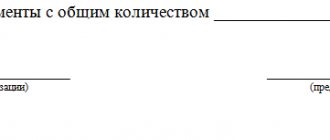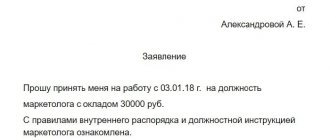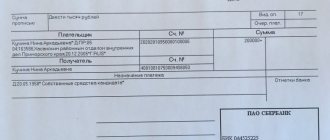The act of receiving and transmitting primary documentation is used during the process of sending documents of high value. This act provides a list of papers that are transferred between organizations or individuals. Thus, the document in question is documentary evidence of the fact that the receiving party received all the papers listed in the form. Let's look at how an act of acceptance and transfer of documentation is drawn up.
The act of acceptance and transfer of documents is an official type of document, according to which the transfer of business documentation from one hand to another is recorded.
What are such acts used for?
This type of act is used by legal entities when it is necessary to transfer documents that are of high importance for each of the parties. These can be either various annexes to the contract or local documents of a particular enterprise. Most often, information about the dismissal or transfer of employees of an organization, as well as the closure of company branches, is transmitted in this way.
Signing in these acts indicates receipt of documents, which helps in the future to prove that the receiving party has fulfilled its obligations . The form in question can be either an integral part of the contract or an independent document in the event that one of the parties requires such documents. It is important to pay attention to the fact that the form in question is endowed with legal force only if the correct drafting is taken into account. This means that this form can act as evidence during legal proceedings.
The act of acceptance and transfer of documentation is drawn up in two copies, one of which is transferred to the recipient, and the second remains with the sender.
Responsibility for using someone else's digital signature
According to Federal Law 63, responsibility for the use of someone else's digital signature lies entirely with the owner of the electronic signature . This is true even if the person who has received the right to use someone else’s digital signature will use it for personal gain. But the owner of the signature then has the right to demand financial or moral compensation in court (such acts are already regulated through the Criminal Code of the Russian Federation, and not the Federal Law).
Moreover, Federal Law 63 clearly states that the recipient of the digital signature is obliged to take all possible steps to prevent third parties from acquiring his signature. This means that it cannot transmit root tokens, passwords for generating keys, and so on. All this is his personal responsibility.
In what cases does it become necessary to draw up an act?
There are many different situations in which such a form may be required. Most often, such acts are concluded between two individuals or legal entities. In the latter case, this document is drawn up if it is necessary to transfer primary documentation as an accompaniment to the public offer. It is also allowed to use the papers in question between legal entities and individuals.
Much more often this type of document is used within one enterprise that has a developed structure. Let's look at the application of acts using specific examples. Imagine a situation where a leading specialist of a company is going through a dismissal procedure. A new employee is hired for this position, whose responsibilities include taking over the affairs of the company.
In order to avoid loss or damage to important documentation, an act is drawn up, which serves as documentary evidence of the fact that all documentation was transferred in proper form.
The act is an integral part of any agreement drawn up between counterparties.
Also, the preparation of this paper may be required in the event of an employee being transferred from one division to another department. In this case, the employee in question must transfer all existing documents to the new officer or other department employees. The need to draw up an act arises when transferring accounting books, administrative and personnel documents, as well as other local documentation.
Next, we propose to move on to more complex cases. One of the situations that requires drawing up an act of acceptance and transfer of documentation is the declaration of bankruptcy. In this case, company employees will need to create several dozen different forms, which are grouped into categories according to the nature of the documents. This act may also be needed in a situation related to the reorganization of business activities. In the event of a merger of several corporations or the consolidation of different departments, it becomes necessary to transfer all current documentation to the new official. It should be noted that in this situation, more than a dozen similar documents are created, each of which deals with a specific department or employee.
Drawing up a form by individuals may be necessary in the case of the provision of various services accompanied by the preparation of important documents . One example of this situation is the transfer of the right to a second party to represent the interests of the first party during legal proceedings. In the example under consideration, important documents, which may be in a single copy, are transferred between private individuals. Also, the form in question can be used as evidence during legal proceedings between individuals.
Compilation rules
A unified form for the document acceptance and transfer certificate has not been established . However, despite this, there are different rules for compiling this form. Ignoring these rules may result in the loss of legal force, which implies the invalidity of the act as proof of the fact of the transfer of files between two companies. That is why it is necessary to approach with increased attention the issue of developing an acceptance certificate.
First of all, the document in question must have the correct title. Next, you should indicate the date and place of drawing up the papers. After this, the form indicates the details of the company acting as the party transferring important papers. Then you should indicate the official whose responsibilities include drawing up the act. The employee's position, last name and initials are indicated here.
Next, information about the recipient of the package of documents is indicated. In the case of legal entities, you should indicate not only the name of the enterprise, but also the form of ownership. Next, you need to provide information about the person whose responsibilities include receiving and processing incoming documentation. Here it is very important to provide the surname and initials of the employee, as well as mention the position he holds.
A document is drawn up at the request of an organization that needs certain documents
After all of the above information has been specified, a table is provided containing data on the transferred files. Here you must indicate the names of the papers, their registration numbers, as well as the form and date of preparation. After this, the document is signed by the transferring party. It is important to pay attention to the fact that the form in question is drawn up in two copies, which are handed over to the recipient.
After checking the presence of all the listed documentation in the act, the official acting as the recipient puts his signature on both forms. One of the forms remains with the receiving party, and the second is given back to the company that sent the documents. In order for the completed form to have legal significance, in addition to the signatures of officials, the company’s seals must be present.
In the case when the papers in question are drawn up between individuals, it is necessary to indicate data from the passport of each party. This information is indicated instead of organizational details. In this situation, only the signatures of the parties are sufficient, since individuals do not have a seal. It is important to pay attention to the fact that when transferring original papers, it is necessary to record this fact on the pages of the act. If these documents are damaged or lost, the acceptance certificate can act as the main document for resolving the conflict with the help of the court. Since there is a certain percentage of risk of such a situation developing, many lawyers recommend making copies of original documents.
Certificate of acceptance and transfer of documents, sample:
“Act of acceptance and transfer of documents, city of Saratov, March 14, 2020
IP "MegaSvet" represented by Artem Mikhailovich Sokolovsky, on the one hand, handed over, and JSC "Polet" represented by Tatyana Ivanovna Orlova, on the other hand, accepted the following documents:
| № | Document's name | Date of preparation | Registration number | Form | Number of sheets |
| 1 | Service Agreement | 13.02.2018 | 12/a | Copy | 10 |
| 2 | Invoice | 10.01.2018 | 15/b | Original | 1 |
This act is drawn up in two copies, one for each party:
Handed over the documents: Sokolovsky A.M. Sokolovsky
Accepted documents: Orlova T.I. Orlova.”
The sample act of acceptance and transfer of documents to another person has exactly the same form, however, instead of the form and name of the organization, the passport details of both parties are indicated.
The legislation of the Russian Federation does not provide for an officially established form of the act of acceptance and transfer of documentation
What is digital signature and what is it used for?
An electronic digital signature guarantees the recipient of the document the following:
- Confirmation of the fact that the signatory is a specific person and no one else.
- The content of the transferred document has not undergone any changes during the transfer process.
- The documentation was indeed sent, and this was done by the owner of the electronic signature.
From a legal point of view, an electronic signature is equivalent to an ordinary signature made with a ballpoint pen . In the Russian Federation, since the beginning of 2013, GOST R 34.10-2012 has been in force, addressing the issue of digital certification and protection of documentation. According to legislators, there are three types of digital signatures:
- A simple electronic digital certifies the fact that the document comes from the person who affixed it.
- Reinforced unskilled . It performs two functions: in addition to confirming authorship, it guarantees that there are no changes in the electronic document after sending.
- Reinforced qualified has the same characteristics as unqualified, except that it is issued in specialized centers that have been accredited by the Ministry of Telecom and Mass Communications.
Various examples of the use of documentation acceptance certificates
Transferring important papers to the accounting department
In the example under consideration, a commission is appointed whose task is to draw up an act on the acceptance and transfer of accounting papers. The need to collect a commission arises when a leading specialist whose job responsibilities included maintaining documents is dismissed. In this case, letterheads installed at the enterprise are used. The act in question specifies the documents that are transferred to the dismissed person - to the new official.
In this case, there is a special form for compiling forms. Information about the transferred accounting books and other accounting records is given in the form of a table. The main requirement when filling out the act is to indicate the following information:
- date of drawing up the act;
- serial number;
- file names.
Transfer of important papers when appointing a new manager
The task of the chief accountant and the head of the enterprise is to certify the primary documents of the enterprise. When there is a change of leadership, this right is transferred to the new official. It is important to note that during changes in the composition of the administration of the enterprise, it is very important to inform the institutions exercising control over the activities of the company. In addition, it is necessary to notify the banking institution servicing the company. This rule applies only to state-owned companies, while private entrepreneurs are left with the right to make independent decisions.
The act of transfer of documents is drawn up in accordance with the established form, on the company’s letterhead. It is important to pay attention to the fact that a change of director implies the emergence of various issues related to the company’s financial fund. In this case, a special commission is created to resolve emerging issues.
Transferring frame files
A form indicating the transfer of personnel records by the resigning person is drawn up in the form prescribed by law. This document should contain parameters such as:
- serial number;
- file name;
- Date of completion;
- number of sheets in the file;
- notes.
In cases of loss of personal files of company employees or the absence of certain records, these nuances are indicated in the “notes” column.
Any enterprise has the right to independently develop this document
Transfer of important papers when appointing a new founder
This process has many different subtleties and nuances associated with the transfer of primary documentation . First of all, a responsible person must be appointed whose job responsibilities will include transferring files. Next, an order is issued to collect the commission. This order should indicate a clear deadline required for sending the documents. During the process of appointing a new founder, the document is transferred only in person.
Transfer of important papers to state custody
Many businesses often share information about their activities with government agencies. This process involves the creation of a form confirming the fact of valuable information about the activities of the enterprise . The need for such actions arises in the event of reorganization measures or liquidation of the organization. In addition, it is necessary to transfer documents to government services after the end of the period of storage of documents on the territory of the enterprise.
The drawn up act must contain the following information:
- The name of the organization that transfers the documents.
- The name of the institution accepting files for storage.
If important documentation is lost, you must make a corresponding note in the report . The notes column contains information about damage or missing documents or individual pages.
Relationships between the parties
When building a relationship between the contractor and the customer regarding the transfer of project documentation, it is important to remember that the ordering party receives not only the project, but also the ownership of the intellectual work associated with the finished documentation. If the investor (customer) does not receive exclusive rights to the project, he does not have the right to take any actions with the information received and apply it in practice.
It turns out that, taking into account the contract agreement, the investor becomes the owner of materials in text and graphic form, as well as information on electronic media. Reworking the project without notifying the creator is prohibited.
In such a situation, it is important for the customer to directly take possession of the project, as well as acquire copyright to the papers. This aspect is achieved by drawing up a direct agreement between the developer (author) of the project, as well as the customer (investor) interested in receiving such information. The document must indicate that when the project is transferred, exclusive rights are transferred, which subsequently remain with the investor (customer), as well as the developer of the papers.
The best option is to conclude an agreement in a tripartite format between the customer (payer), the design company and the customer (receiving and supervisory authority). If there is no investor as such, this option when drawing up the contract rests with the ordering party. In such a situation, it is the customer who receives exclusive rights to the finished project, unless another condition is specified in the agreement between the parties.
A three-way format of interaction between the parties is considered optimal. If the client is an involved party, the payment to the design company is made by the investor. If the latter refuses to pay, the customer will have to bear responsibility for failure to complete tasks before the author. The latter risks that the project he has prepared will be transferred to the benefit of a third party (investor), and the likelihood of protecting his rights is reduced. In addition, if the investor is not included in the agreement, he loses the full right to participate in the process of creating the project. In the case of a tripartite relationship format, all participants are protected, and the risk is minimized.
See also: Sergey Levkin: All capital objects should become reference ones









